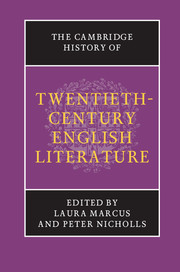Book contents
- Frontmatter
- Introduction
- PART ONE WRITING MODERNITY
- PART TWO THE EMERGING AVANT-GARDE
- PART THREE MODERNISM AND ITS AFTERMATH, 1918–1945
- 10 Trauma and war memory
- 11 The time–mind of the twenties
- 12 Modern life: fiction and satire
- 13 Modernist poetry and poetics
- 14 Modernity and myth
- 15 Psychoanalysis and literature
- 16 Biography and autobiography
- 17 ‘Speed, violence, women, America’: popular fictions
- 18 Theatre and drama between the wars
- 19 Literature and cinema
- 20 The thirties: politics, authority, perspective
- 21 Literary criticism and cultural politics
- 22 Surrealism in England
- 23 World War II: contested Europe
- 24 World War II: the city in ruins
- PART FOUR POST-WAR CULTURES, 1945–1970
- PART FIVE TOWARDS THE MILLENNIUM, 1970–2000
- Bibliography
- Index
- References
11 - The time–mind of the twenties
from PART THREE - MODERNISM AND ITS AFTERMATH, 1918–1945
Published online by Cambridge University Press: 28 March 2008
- Frontmatter
- Introduction
- PART ONE WRITING MODERNITY
- PART TWO THE EMERGING AVANT-GARDE
- PART THREE MODERNISM AND ITS AFTERMATH, 1918–1945
- 10 Trauma and war memory
- 11 The time–mind of the twenties
- 12 Modern life: fiction and satire
- 13 Modernist poetry and poetics
- 14 Modernity and myth
- 15 Psychoanalysis and literature
- 16 Biography and autobiography
- 17 ‘Speed, violence, women, America’: popular fictions
- 18 Theatre and drama between the wars
- 19 Literature and cinema
- 20 The thirties: politics, authority, perspective
- 21 Literary criticism and cultural politics
- 22 Surrealism in England
- 23 World War II: contested Europe
- 24 World War II: the city in ruins
- PART FOUR POST-WAR CULTURES, 1945–1970
- PART FIVE TOWARDS THE MILLENNIUM, 1970–2000
- Bibliography
- Index
- References
Summary
When you thought of Time in those days your mind wavered impotently like eyes tired by reading too small print.
(Ford Madox Ford, A Man Could Stand Up)It takes it out of you, certainly, Time.
(Wyndham Lewis, The Childermass)This extraordinary discrepancy between time on the clock and time in the mind is less well known than it should be and deserves fuller investigation.
(Virginia Woolf, Orlando)The British Modernist novel did not discover time in the years after the World War I. Before Modernism, outside Britain, and in other genres, the mysteries of temporality had disclosed themselves. Within the English novel, Sterne’s Tristram Shandy and Emily Brontë’s Wuthering Heights are luminous and unforgettable precedents. But there can be little doubt that in the first post-war decade, at a moment of vaulting ambition in the High Modernist novel, time became such a dominant concern that it can be taken as a cultural signature. In the years after the war, it ceased to be a background for literary events, an invisible medium surrounding the enactment of a plot. It became rather a fully thematised subject in its own right – a fact that can be seen in the epigraphs to this chapter, where time becomes an upper-case abstraction, indeed a protagonist as real as the fictive human agents.
At the outset we need to distinguish three aspects of the problem: (1) the time of modernisation that surrounds and permeates the literary experiments; (2) the representation of temporality within the fictional world; and (3) the forms and structures of narrative time.
- Type
- Chapter
- Information
- The Cambridge History of Twentieth-Century English Literature , pp. 197 - 217Publisher: Cambridge University PressPrint publication year: 2005
References
- 1
- Cited by

